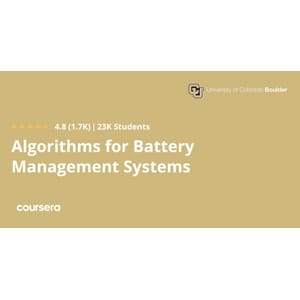Algorithms for Battery Management Systems Specialization

About Course
Algorithms for Battery Management Systems Specialization
Master the design and implementation of algorithms for battery management systems (BMS) with this comprehensive specialization, available **completely free of cost** on Theetay. Developed by the University of Colorado, this course delves into crucial aspects of BMS, including:
- Fundamentals of Battery Management Systems: Gain a solid understanding of BMS functions and their significance.
- Lithium-Ion Battery Technology: Explore the inner workings of lithium-ion battery cells and learn to model their behavior mathematically.
- Algorithm Development: Learn to design and implement algorithms for essential BMS tasks like state-of-charge (SOC), state-of-health (SOH), remaining energy, and available power estimation.
- Cell Balancing Techniques: Master strategies for maintaining a balanced charge in battery packs, extending their lifespan and performance.
This specialization provides practical experience through code templates (in Octave/MATLAB), enabling you to build your own simulations and algorithms. Whether you’re a student, engineer, or simply passionate about battery technology, this course offers invaluable knowledge and skills.
Enroll now for free!
Keywords: Battery Management Systems, BMS, Algorithms, Lithium-Ion Batteries, State-of-Charge (SOC), State-of-Health (SOH), Remaining Energy, Available Power, Cell Balancing, Battery Pack, Octave, MATLAB, Free Online Courses, Udemy, Udacity, Coursera, MasterClass, NearPeer
Course Content
01. Introduction to battery-management systems
-
0006 002_1-0-introduction-to-the-specialization.mp4
00:00 -
0007 003_frequently-asked-questions_instructions.html
00:00 -
0008 004_course-resources_Battery-Management-Systems-Volume-1-Battery-Modeling-P1752.aspx
00:00 -
0010 005_how-to-use-discussion-forums_instructions.html
00:00 -
0011 006_get-help-and-meet-other-learners-in-this-course-join-your-discussion-forums_instructions.html
00:00 -
0012 007_earn-a-course-certificate_instructions.html
00:00 -
0013 008_are-you-interested-in-earning-an-msee-degree_instructions.html
00:00 -
0015 001_notes-for-lesson-1-1-1_Lesson1-1-1-handout.pdf
00:00 -
0019 002_1-1-1-welcome-to-the-course.mp4
00:00 -
0021 001_notes-for-lesson-1-1-2_Lesson1-1-2-handout.pdf
00:00 -
0025 002_1-1-2-introducing-important-battery-terminology.mp4
00:00 -
0027 001_notes-for-lesson-1-1-3_Lesson1-1-3-handout.pdf
00:00 -
0031 002_1-1-3-what-are-the-parts-of-an-electrochemical-cell.mp4
00:00 -
0033 001_notes-for-lesson-1-1-4_Lesson1-1-4-handout.pdf
00:00 -
0037 002_1-1-4-how-does-an-electrochemical-cell-store-and-release-energy.mp4
00:00 -
0039 001_notes-for-lesson-1-1-5_Lesson1-1-5-handout.pdf
00:00 -
0043 002_1-1-5-what-are-the-best-materials-to-use-in-an-electrochemical-cell.mp4
00:00 -
0045 001_notes-for-lesson-1-1-6_Lesson1-1-6-handout.pdf
00:00 -
0049 002_1-1-6-example-electrochemical-incl-pba-and-nimh-cells.mp4
00:00 -
0051 001_notes-for-lesson-1-1-7_Lesson1-1-7-handout.pdf
00:00 -
0055 002_1-1-7-summary-of-battery-boot-camp-module-plus-next-steps.mp4
00:00 -
0057 001_notes-for-lesson-1-2-1_Lesson1-2-1-handout.pdf
00:00 -
0061 002_1-2-1-benefits-of-lithium-ion-cells.mp4
00:00 -
0063 001_notes-for-lesson-1-2-2_Lesson1-2-2-handout.pdf
00:00 -
0067 002_1-2-2-what-makes-lithium-ion-cells-different-from-electrochemical-cells.mp4
00:00 -
0069 001_notes-for-lesson-1-2-3_Lesson1-2-3-handout.pdf
00:00 -
0073 002_1-2-3-negative-electrodes-for-lithium-ion-cells.mp4
00:00 -
0075 001_notes-for-lesson-1-2-4_Lesson1-2-4-handout.pdf
00:00 -
0079 002_1-2-4-positive-electrodes-for-lithium-ion-cells.mp4
00:00 -
0081 001_notes-for-lesson-1-2-5_Lesson1-2-5-handout.pdf
00:00 -
0085 002_1-2-5-electrolytes-and-separators-for-lithium-ion-cells.mp4
00:00 -
0087 001_notes-for-lesson-1-2-6_Lesson1-2-6-handout.pdf
00:00 -
0091 002_1-2-6-is-lithium-going-to-run-out.mp4
00:00 -
0093 001_notes-for-lesson-1-2-7_Lesson1-2-7-handout.pdf
00:00 -
0097 002_1-2-7-summary-of-how-lithium-ion-cells-work-module-plus-next-steps.mp4
00:00 -
0099 001_notes-for-lesson-1-3-1_Lesson1-3-1-handout.pdf
00:00 -
0103 002_1-3-1-what-are-the-primary-functions-of-a-bms.mp4
00:00 -
0105 001_notes-for-lesson-1-3-2_Lesson1-3-2-handout.pdf
00:00 -
0109 002_1-3-2-what-are-some-reasons-for-modular-design.mp4
00:00 -
0111 001_notes-for-lesson-1-3-3_Lesson1-3-3-handout.pdf
00:00 -
0115 002_1-3-3-how-to-sense-all-cell-voltages-in-a-bms.mp4
00:00 -
0117 001_notes-for-lesson-1-3-4_Lesson1-3-4-handout.pdf
00:00 -
0121 002_1-3-4-how-to-sense-module-temperature-in-a-bms.mp4
00:00 -
0123 001_notes-for-lesson-1-3-5_Lesson1-3-5-handout.pdf
00:00 -
0127 002_1-3-5-how-to-sense-battery-pack-current-in-a-bms.mp4
00:00 -
0129 001_notes-for-lesson-1-3-6_Lesson1-3-6-handout.pdf
00:00 -
0133 002_1-3-6-how-to-control-contactors-with-a-bms.mp4
00:00 -
0135 001_notes-for-lesson-1-3-7_Lesson1-3-7-handout.pdf
00:00 -
0139 002_1-3-7-how-to-sense-electrical-isolation-in-a-bms.mp4
00:00 -
0141 001_notes-for-lesson-1-3-8_Lesson1-3-8-handout.pdf
00:00 -
0145 002_1-3-8-how-to-control-battery-pack-temperature-with-a-bms.mp4
00:00 -
0147 001_notes-for-lesson-1-3-9_Lesson1-3-9-handout.pdf
00:00 -
0151 002_1-3-9-summary-of-bms-sensing-and-high-voltage-control-module-plus-next-steps.mp4
00:00 -
0153 001_notes-for-lesson-1-4-1_Lesson1-4-1-handout.pdf
00:00 -
0157 002_1-4-1-how-can-a-bms-protect-the-user-and-battery-pack.mp4
00:00 -
0159 001_notes-for-lesson-1-4-2_Lesson1-4-2-handout.pdf
00:00 -
0165 002_1-4-2-how-must-a-bms-interface-with-other-system-components.mp4
00:00 -
0167 001_notes-for-lesson-1-4-3_Lesson1-4-3-handout.pdf
00:00 -
0171 002_1-4-3-why-must-a-bms-estimate-soc-and-soh.mp4
00:00 -
0173 001_notes-for-lesson-1-4-4_Lesson1-4-4-handout.pdf
00:00 -
0177 002_1-4-4-what-are-cell-soc-and-battery-pack-soc.mp4
00:00 -
0179 001_notes-for-lesson-1-4-5_Lesson1-4-5-handout.pdf
00:00 -
0183 002_1-4-5-how-do-i-compute-cell-available-energy-and-power.mp4
00:00 -
0185 001_notes-for-lesson-1-4-6_Lesson1-4-6-handout.pdf
00:00 -
0189 002_1-4-6-how-do-i-compute-battery-pack-available-energy-and-power.mp4
00:00 -
0191 001_notes-for-lesson-1-4-7_Lesson1-4-7-handout.pdf
00:00 -
0195 002_1-4-7-what-kinds-of-diagnostics-must-a-bms-report.mp4
00:00 -
0197 001_notes-for-lesson-1-4-8_Lesson1-4-8-handout.pdf
00:00 -
0201 002_1-4-8-summary-of-bms-design-requirements-2-5-module-plus-next-steps.mp4
00:00 -
0203 001_notes-for-lesson-1-5-1_Lesson1-5-1-handout.pdf
00:00 -
0207 002_1-5-1-how-are-a-lithium-ion-cells-electrodes-fabricated.mp4
00:00 -
0209 001_notes-for-lesson-1-5-2_Lesson1-5-2-handout.pdf
00:00 -
0213 002_1-5-2-how-is-a-lithium-ion-cell-assembled.mp4
00:00 -
0215 001_notes-for-lesson-1-5-3_Lesson1-5-3-handout.pdf
00:00 -
0219 002_1-5-3-what-are-normal-lithium-ion-cell-aging-processes.mp4
00:00 -
0221 001_notes-for-lesson-1-5-4_Lesson1-5-4-handout.pdf
00:00 -
0225 002_1-5-4-what-are-abnormal-cell-aging-processes-and-failure-modes.mp4
00:00 -
0227 003_notes-for-lesson-1-5-5_Lesson1-5-5-handout.pdf
00:00 -
0231 004_1-5-5-summary-of-how-are-cells-made-how-can-they-fail-module-plus-next-steps.mp4
00:00 -
links.txt
00:00
02. Equivalent Circuit Cell Model Simulation
03. Battery State-of-Charge (SOC) Estimation
04. Battery State-of-Health (SOH) Estimation
05. Battery Pack Balancing and Power Estimation
Earn a certificate
Add this certificate to your resume to demonstrate your skills & increase your chances of getting noticed.

Student Ratings & Reviews


